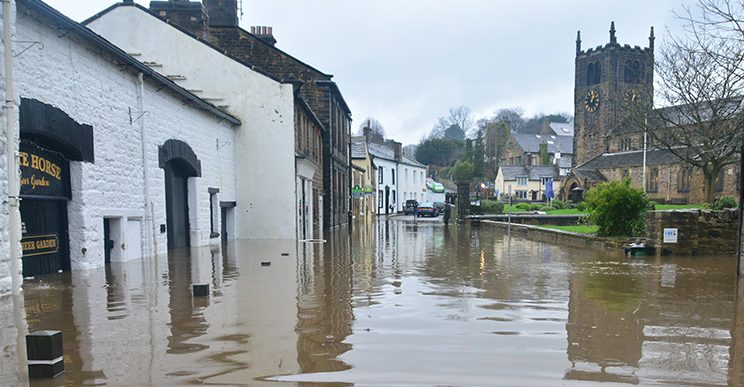
A personal reflection on how to support companies into the growing market for Property Flood Resilience from Flood Innovation Centre Technology Research Manager, Elena Kuvshinova.
In the last 20 years the UK has suffered multiple major flooding events and changes to the climate brought about by global warming are predicted to increase both the severity and frequency of storms, with a commensurate increase in flooding.
The Environment Agency estimates that annual flood damage costs are in the region of £1.1billion and could rise to as much as £27billion by 2080.
Every flooded property represents a financial loss, but also disruption to the lives of those affected, to businesses, the loss of utilities, closed roads and schools, problems for the NHS and much more.
Our flood risk is growing. We as individuals, communities and society need to understand this risk and take action. How can we improve our preparedness, our ability to protect ourselves and quickly recover from the devastating effects?

In the Humber area, we are particularly susceptible to flooding – from rivers, the sea, the sky – and sometimes, all three! In fact, the Humber is the most flood-prone area in the UK after the Thames estuary. One solution is to create climate resilient places.
Simply speaking, to cope with upcoming floods we need to build up our resilience. The need for resilience is reflected in government policy, which has switched from promoting total flood protection to building flood resilience. The main difference being the addition of steps to make properties more recoverable when a flood does occur: current Property Flood Resilience (PFR) policy isn’t just about stopping the water getting in, it’s about getting back to normal when it has.
As this PFR approach is relatively new, there is currently a lack of awareness of not only what PFR products are available but who would benefit from such products. Householders’ ability to understand their own flood risk has usually been communicated by flood risk mapping, which the Environmental Agency (EA) produces based on the potential risk and impacts of flooding. These maps are based on historical statistical data, but in climate change conditions this approach is not reliable any more – they also don’t take into account surface water flood risk.
Climate change means flood events previously categorised with a likelihood of 1 in 100 years, may happen every 15, 10 or 5 years. Multi-agency engagement is needed to help people understand their risk and their options to increase resilience.
You may ask, why can’t the PFR market grow organically? Why does it need support? As well as a lack of awareness of the products and their utility, businesses are at a disadvantage because of the novelty of the market. There has not yet been enough time for companies to build up their reputation, and, as a result, there is lack of available information about trustworthy manufacturers and providers of PFR products and services. The majority of businesses operating in the PFR market are currently SMEs, who have the flexibility to be able to respond to a need for product innovation and tend to operate locally. However, they lack the budgets of major corporations to enable the successful marketing of their new products.
As floods happen more regularly, the need for PFR products is going to grow. So, what can be done to support this fledgling industry?
On a national and regional scale, flood risk and resilience are managed by multiple agencies, from DEFRA and the Environment Agency, through to the Lead Local Flood Authorities, including local councils, drainage boards and emergency services. This group plays an important role in the discussion and development of flood plans, flood resilience standards, requirements for installation and maintenance of PFR measures. They also take an active part in the innovation process within the PFR market, explaining their needs and developing and spreading the necessary safety information. They have a significant role in determining demand, for example, by allocating budget to the supply of temporary flood barriers. These kinds of national and regional measures are only part of the story – flood resilience at an individual property level is also needed.
Insurance companies are the main point of contact for the majority of flooded households, when faced with the need to repair or replace flood-damaged property. Recent research estimated that making a claim related to flooding adds £72 to an insurance premium on average, while a history of flooding can result in a £120 uplift (Money Supermarket research, 2021). A scheme that rewards the uptake of flood resilience measures with reduced premiums would encourage individual householders to improve their resilience – households would then suffer less damage and would recover more quickly in the event of a flood.

So, both government and non-governmental agencies have a role to play but individual householders are also key. The first and most obvious step in developing the PFR market is raising awareness amongst householders and communities about flood risk, the possible damage it could cause and the available PFR measures. This can be done through educational programs, by preparing and spreading information resources and wider promotion of PFR products in local communities. Regional organisations like Pathfinder are already doing important work in this field.
Another important factor in the growth of the PFR market is the development of programs for investment risk management for companies thinking about moving into the PFR sector. Our society needs these new products to improve our ability to cope with flood but until there is an obvious demand from actual customers, it remains a risk to move into this new market area.
My own organisation, the Flood Innovation Centre, plays a modest but sophisticated role in this new movement towards flood resilience, providing support for innovation on the PFR market. We target support to SMEs to develop flood resilience innovations; with ERDF funding and access to a wide range of expertise, we can build a package of support that is most appropriate to their situation and their specific area of innovation.
We also run in-depth workshop and training events, including a recent PFR workshop bringing together SMEs with government agencies, innovation specialists and organisations like Pathfinder. Participants felt that the workshops met an urgent need for a place where they could meet SMEs and flood specialists to share their problems, find sources of essential information and build up business relationships.
Targeted financial support for the adoption of PFR measures in high flood risk areas would allow the PFR market to develop in a positive direction. A wider implementation of transitional insurance policies both for households and business would also stimulate growth of sales of PFR products and services as well.
Active support of the initial stage of development of the PFR market would bring a significant profit to the communities and society: it would reduce the impact of floods while aiding business growth amongst local sustainable supply chains. If agencies can come together, and crucially, awareness can be raised amongst the public, together we can create real impact across our communities, better preparing the region for rising flood risks and creating a resilient future in the face of climate change.
The Flood Innovation Centre at the University of Hull has been established to help small and medium businesses develop innovative services, processes and products in flood resilience. We offer bespoke support packages to help you get your flood innovation idea moving, alongside training & networking opportunities.
If you are interested in finding out more, please get in touch, we would love to hear from you!
Elena Kuvshinova, Technology Research Manager, Flood Innovation Centre